25 Jun Ankle Syndesmotic Injury

High ankle sprains or syndesmotic injuries are common and can be crippling. There’s an ankle sprain about every two minutes in the United States and approximately one in ten will have an injury to the syndesmosis.
The ankle syndesmosis is composed of fibrous ligaments uniting the tibia and fibula. This ligament is very important for weight transfer during walking. The syndesmotic ligaments provide stability and allow the fibula to rotate somewhat relative to the tibia. These ligaments give strong oppositional force to the fibula providing strong dynamic force to the ankle mortise.
How is the injury sustained? Syndesmotic injuries usually result when an external rotation force acts on the foot relative to the tibia. This means the foot is moving outward while the lower leg remains somewhat stationary. It’s possible to have a syndesmotic injury with or without (high ankle sprain) a fracture to the ankle.
Your foot and ankle surgeon will perform a history and physical along with obtaining x-rays of your ankle. Other studies that may be ordered to aid in detecting syndesmotic injuries include computed tomography (CT), magnetic resonance imaging (MRI) and arthroscopy of the ankle. These advanced studies are usually ordered for patients that have continued or chronic pain and where clinical and radiographic evaluations are not definitive.
What’s the purpose? The goal when treating syndesmotic injuries of the ankle is the reduction and maintenance of proper alignment of the ankle joint. This is accomplished with surgery requiring fixation of the syndesmotic ligament with either metal or absorbable screws (no need for removal) or a type of strong suture repair with FibreWire (see animated video below). The FibreWire repair provides semi-rigid dynamic repair and there is no need to remove hardware and undergo a second surgery. Post-operative recovery is surgeon dependent, however most patients will remain nonweightbearing with a cast and crutches until boney healing of the ankle fracture is achieved.
If you’ve suffered an ankle injury and continue with pain, further evaluation and treatment are necessary.

